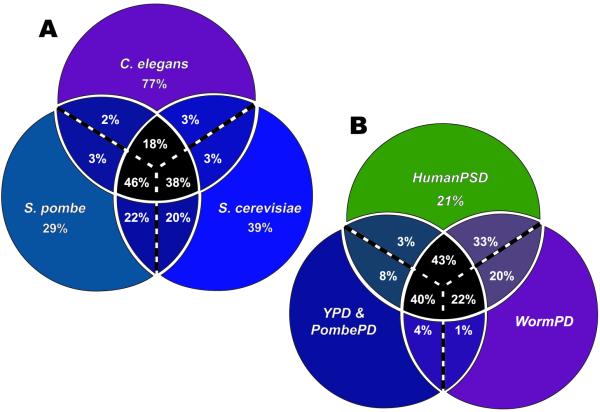Figure 1.
(A) Proportion of proteins conserved among the model organisms. Each circle represents the set of proteins analyzed from that species and contained in the corresponding Proteome database. Complete sets of the predicted proteins (as of September 2000) of S.cerevisiae (6145 proteins) and C.elegans (18 546 proteins) and a nearly complete set of S.pombe predicted proteins (4837) were compared with each other using BLAST analysis (6,7), and matches with an E value of 1 × 10–10 or lower were counted. In the intersection of all three circles (colored in black) are proteins that find a match in all three species, represented as the percentage of total proteins in that species. At the intersection of each pair of circles is the percentage of proteins conserved between those two species but not found in the third, by these criteria. For example, 38% of S.cerevisiae proteins find a match in both S.pombe and C.elegans; 20% match S.pombe but not C.elegans; and 3% match C.elegans but not S.pombe. The proportions of proteins similar to a protein of at least one of the other species are: 61% of S.cerevisiae proteins, 71% of S.pombe proteins and 23% of C.elegans proteins find a match in at least one of the other species. (B) Comparison of predicted proteins of the model yeasts (S.cerevisiae, 6145 proteins and S.pombe, 4837 proteins), C.elegans (18 546 proteins) and mammals (10 229 from human, 5966 from mouse and 3188 from rat), as represented in the indicated volumes of the BioKnowledge Library as of September 2000. The proteins analyzed represent the complete predicted proteomes of S.cerevisiae and C.elegans, the nearly complete proteome of S.pombe and a partial set of mammalian proteins. Criteria for counting similar proteins were the same as for the comparison of (A). Proteins conserved in all three species are indicated in the intersection of all three circles, as in (A). The proportions of proteins similar to a protein of at least one of the other species are: 79% of the mammalian proteins, 43% of the C.elegans proteins and 52% of the model yeast proteins.

